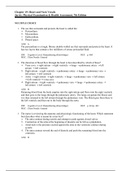Nr 509 chapter 19 - Study guides, Class notes & Summaries
Looking for the best study guides, study notes and summaries about Nr 509 chapter 19? On this page you'll find 22 study documents about Nr 509 chapter 19.
Page 2 out of 22 results
Sort by
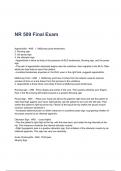
-
NR 509 Final Exam
- Exam (elaborations) • 21 pages • 2024
-
- $15.99
- + learn more
NR 509 Final Exam Appendicitis - ANS 1. McBurney point tenderness 2. Rovsing sign 3. the psoas sign 4. the obturator sign --Appendicitis is twice as likely in the presence of RLQ tenderness, Rovsing sign, and the psoas sign --The pain of appendicitis classically begins near the umbilicus, then migrates to the RLQ. Older adults are less likely to report this pattern. --Localized tenderness anywhere in the RLQ, even in the right flank, suggests appendicitis. McBurney Point - ANS...
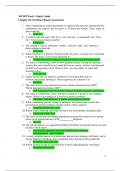
-
NR 509 Week 1 Study Guide
- Exam (elaborations) • 27 pages • 2023
-
- $9.99
- + learn more
NR 509 Week 1 Study Guide Chapter 01: Evidence-Based Assessment 1. After completing an initial assessment of a patient, the nurse has charted that his respirations are eupneic and his pulse is 58 beats per minute. These types of data would be: a. Objective. 2. A patient tells the nurse that he is very nervous, is nauseated, and “feels hot.” These types of data would be: a. Subjective. 3. The patient’s record, laboratory studies, objective data, and subjective data combine to form t...
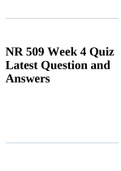
-
NR 509 Week 4 Quiz Latest Question and Answers
- Exam (elaborations) • 16 pages • 2022
-
- $10.49
- + learn more
NR 509 Week 4 Quiz Latest Question and Answers. Chapter 19: Heart and Neck Vessels 1. The sac that surrounds and protects the heart is called the: a. Pericardium. b. Myocardium. c. Endocardium. d. Pleural space. 2. The direction of blood flow through the heart is best described by which of these? a. Vena cava right atrium right ventricle lungs pulmonary artery left atrium left ventricle b. Right atrium right ventricle pulmonary artery lungs pulmonary vein left atrium left ventricle c. A...

-
NR 509 Final Exam With Questions And Answers
- Exam (elaborations) • 21 pages • 2023
-
Available in package deal
-
- $11.99
- + learn more
NR 509 Final Exam With Questions And Answers NR 509 Final Exam Appendicitis - ANS 1. McBurney point tenderness 2. Rovsing sign 3. the psoas sign 4. the obturator sign --Appendicitis is twice as likely in the presence of RLQ tenderness, Rovsing sign, and the psoas sign --The pain of appendicitis classically begins near the umbilicus, then migrates to the RLQ. Older adults are less likely to report this pattern. --Localized tenderness anywhere in the RLQ, even in the right flank, su...
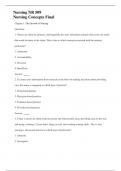
-
Nursing NR 509 Nursing Concepts Final
- Exam (elaborations) • 448 pages • 2023
-
- $9.99
- + learn more
Nursing NR 509 Nursing Concepts Final Chapter 1: The Growth of Nursing Questions 1. Nurses are often the primary, and frequently the only, defendants named when errors are made that result in injury to the client. This is due to which concept associated with the nursing profession? 1. Autonomy 2. Accountability 3. Precision 4. Specificity Answer: 2. If a nurse uses information from research as the basis for making decisions about providing care, this nurse is engaging in which...
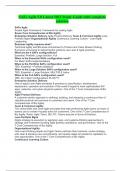
-
NR 509 Final Exam (Answered) Appendicitis 1. McBurney point tenderness
- Exam (elaborations) • 15 pages • 2023
-
- $11.49
- + learn more
NR 509 Final Exam (Answered) Appendicitis 1. McBurney point tenderness 2. Rovsing sign 3. the psoas sign 4. the obturator sign --Appendicitis is twice as likely in the presence of RLQ tenderness, Rovsing sign, and the psoas sign --The pain of appendicitis classically begins near the umbilicus, then migrates to the RLQ. Older adults are less likely to report this pattern. --Localized tenderness anywhere in the RLQ, even in the right flank, suggests appendicitis. McBurney Point 1. McBurn...

-
NR 511 Week 4 Midterm Answers (Summer 2018){100%}(LATEST UPDATE)
- Exam (elaborations) • 11 pages • 2021
-
- $27.49
- + learn more
NR 511 Week 4 Midterm Answers (Summer 2018) 1. Define diagnostic reasoning Reflective thinking because the process involves questioning one’s thinking to determining if all possible avenues have been explored and if the conclusions that are being drawn are based on evidence. *Seen as a kind of critical thinking. 2. Discuss and identify subjective & objective data - Subjective: What the pt tells you, complains of, etc. *Chief complaint, HPI, ROS - Objective: What YOU can see, hear, or feel as p...
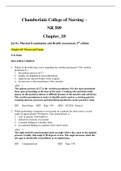
-
NR 509 Chapter 18: Thorax and Lungs Jarvis: Physical Examination and Health Assessment, 5th edition Chapter 18: Thorax and Lungs
- Exam (elaborations) • 17 pages • 2021
-
- $15.49
- + learn more
NR 509 Chapter 18: Thorax and Lungs Jarvis: Physical Examination and Health Assessment, 5th edition Chapter 18: Thorax and Lungs Chamberlain College of Nursing – NR 509 Chapter_18 Jarvis: Physical Examination and Health Assessment, 5th edition Chapter 18: Thorax and Lungs Text Bank MULTIPLE CHOICE 1. Which of the following is true regarding the vertebra prominens? The vertebra prominens is: 1. the spinous process of C7. 2. usually not palpable in most individuals. 3. opposite the i...
NR 509 -Jarvis Chapter 19 - 7th Ed Test Bank. Chapter 19: Heart and Neck Vessels Jarvis: Physical Examination & Health Assessment, 7th Edition MULTIPLE CHOICE
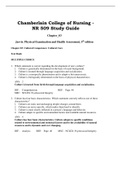
-
NR 509 Study Guide Chapter 03 Jarvis: Physical Examination and Health Assessment, 5th edition Text Bank
- Exam (elaborations) • 16 pages • 2021
-
- $15.50
- + learn more
NR 509 Study Guide Chapter 03 Jarvis: Physical Examination and Health Assessment, 5th edition Text Bank Chamberlain College of Nursing - NR 509 Study Guide Chapter_03 Jarvis: Physical Examination and Health Assessment, 5th edition Chapter 03: Cultural Competence: Cultural Care Text Bank MULTIPLE CHOICE 1. Which statement is correct regarding the development of one’s culture? 1. Culture is genetically determined on the basis of racial background. 2. Culture is learned through language...

That summary you just bought made someone very happy. Also get paid weekly? Sell your study resources on Stuvia! Discover all about earning on Stuvia



